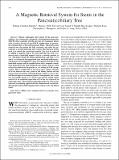A Magnetic Retrieval System for Stents in the Pancreaticobiliary Tree
Author(s)
Cantillon-Murphy, Padraig; Ryou, Marvin; Shaikh, Sohail N.; Azagury, Dan; Ryan, Michele; Thompson, Christopher C.; Lang, Jeffrey H.; ... Show more Show less
DownloadCantillon-Murphy-2010-A Magnetic Retrieval.pdf (319.5Kb)
PUBLISHER_POLICY
Publisher Policy
Article is made available in accordance with the publisher's policy and may be subject to US copyright law. Please refer to the publisher's site for terms of use.
Terms of use
Metadata
Show full item recordAbstract
Clinical endoscopic intervention of the pancreaticobiliary tree [endoscopic retrograde cholangiopancreatography (ERCP)] often concludes with the insertion of a temporary plastic stent to reduce the risk of post-ERCP complications by promoting continued flow of bile and pancreatic fluids. This stent is later removed once the patient has fully recovered, but today this necessitates a second endoscopic intervention. The final goal of this work is to obviate the second intervention. This is to be achieved by adding a magnetic ring to the stent such that the stent is removed using a hand-held magnet, held in a suitable position ex vivo . This paper details the design, optimization, and both ex vivo and in vivo testing of the magnetized stent and hand-held magnet, which has been accomplished to date. The optimized design for the hand-held magnet and the modified stent with a magnetic attachment performs in line with simulated expectations, and successful retrieval is achieved in the porcine ex vivo setting at 9-10 cm separation. This is comparable to the mean target capture distance of 10 cm between the entry point to the biliary system and the closest cutaneous surface, determined from random review of clinical fluoroscopies in ten human patients. Subsequently, the system was successfully tested in vivo in the acute porcine model, where retrieval at an estimated separation of 5-6 cm was captured on endoscopic video. These initial results indicate that the system may represent a promising approach for the elimination of a second endoscopic procedures following placement of pancreatic and biliary stents.
Date issued
2010-08Department
Massachusetts Institute of Technology. Department of Electrical Engineering and Computer ScienceJournal
IEEE Transactions on Biomedical Engineering
Publisher
Institute of Electrical and Electronics Engineers
Citation
Cantillon-Murphy, P. et al. “A Magnetic Retrieval System for Stents in the Pancreaticobiliary Tree.” Biomedical Engineering, IEEE Transactions on 57.8 (2010): 2018-2025. © 2011 IEEE.
Version: Final published version
Other identifiers
INSPEC Accession Number: 11510525
ISSN
0018-9294